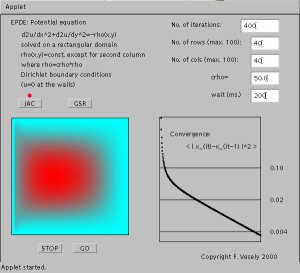


Next: 2.3.3 Gauss-Seidel Relaxation (GSR)
Up: 2.3 Iterative Methods
Previous: 2.3.1 Iterative Improvement
2.3.2 Jacobi Relaxation
Divide the given matrix according to
 where
where
 contains only the diagonal elements of
contains only the diagonal elements of
 , while
, while
 and
and
 are the left and right parts of
are the left and right parts of
 , respectively.
, respectively.
Choose
 and write the iteration formula as
and write the iteration formula as
or
EXAMPLE:
In
 let
let
Starting from the estimated solution
and using the diagonal part of
 ,
,
in the iteration we find the increasingly more accurate solutions
Convergence rate:
Writing the Jacobi scheme in the form
with the Jacobi block matrix
convergence requires that all eigenvalues of
 be smaller than one
(by absolute value). Denoting the largest eigenvalue (the
spectral radius) of
be smaller than one
(by absolute value). Denoting the largest eigenvalue (the
spectral radius) of
 by
by  , we have for the asymptotic rate of convergence
, we have for the asymptotic rate of convergence
In the above example
 and
and
 .
.
The electrostatic problem shown before was treated by Jacobi
iteration:



Next: 2.3.3 Gauss-Seidel Relaxation (GSR)
Up: 2.3 Iterative Methods
Previous: 2.3.1 Iterative Improvement
Franz J. Vesely Oct 2005
See also: "Computational Physics - An Introduction," Kluwer-Plenum 2001






